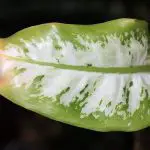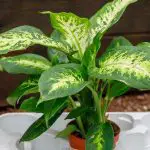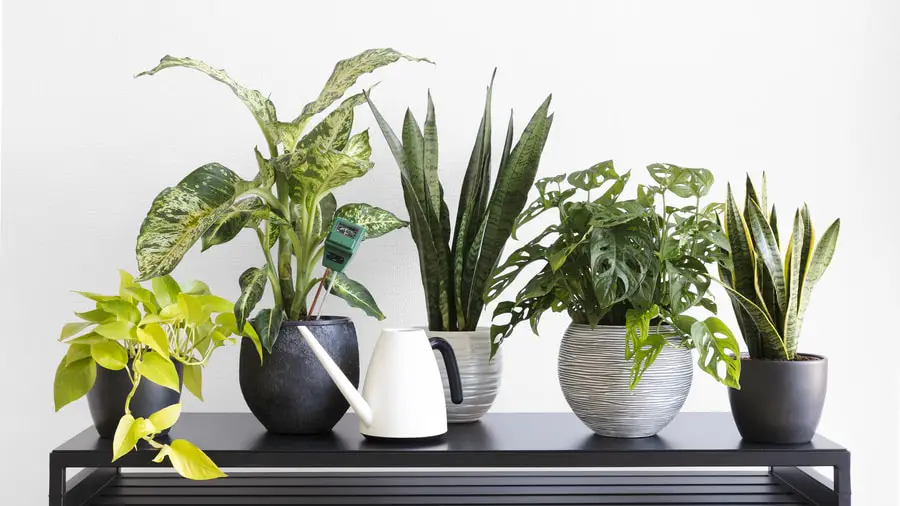
I’ve suffered from seasonal allergies ever since we moved to the midwest seven years ago. There’s something in the air – especially in spring and fall – that my body just doesn’t like. After years of growing houseplants, I’ve found the best ones to help purify the air and prevent side effects related to allergies.
Peace Lily, Dracaena, Areca Palm, English Ivy, Spider Plant, Golden Pothos, Philodendron, Snake Plant, Rubber Tree, and Dieffenbachia filter toxins from air and keep your indoor environment free of allergens. Plus, they have lower pollen counts that won’t exacerbate allergies.
Let’s take a closer look at these plants, including how to care for them in your home. I chose easy-to-grow plants that have the biggest impact on allergies.
Peace Lily

The low maintenance and easy-to-grow Peace Lily (Spathiphyllum) is one of the best indoor plants for purifying the air. It breaks down and neutralizes toxic gases that are common indoors, such as benzene, carbon monoxide, and formaldehyde. Peace lilies are also effective in removing mold spores from the air.
If you’re sensitive to pollen, Peace Lily is a good choice because it produces pollen that’s stickier and heavier than other flowers, making it less likely to stay in the air and cause irritation.
| Light | Medium, indirect light is best, but will tolerate lower light conditions. May not bloom if there’s not enough light, and yellowing leaves indicate too much light. |
| Temperature | Peace lily is a tropical plant, so don’t let it get too cold. Minimum temperature it can tolerate is 55 degrees F. |
| Humidity | High Humidity – above 50% if possible. Place near a humidifier or on a humidity tray (a shallow tray filled with pebbles and water). Misting helps in very dry conditions. |
| Water | Moist, but not wet soil. Never allow soil to completely dry. Water as needed to keep the soil consistently moist. Plants will use more water in winter than summer when indoor air is drier. Peace lily droops when water is needed. |
| Fertilizer | Balanced houseplant fertilizer such as 20-20-20 diluted to half strength is best. Apply water after feeding to distribute to the roots. Fertilize in the summer months only. |
Dracaena
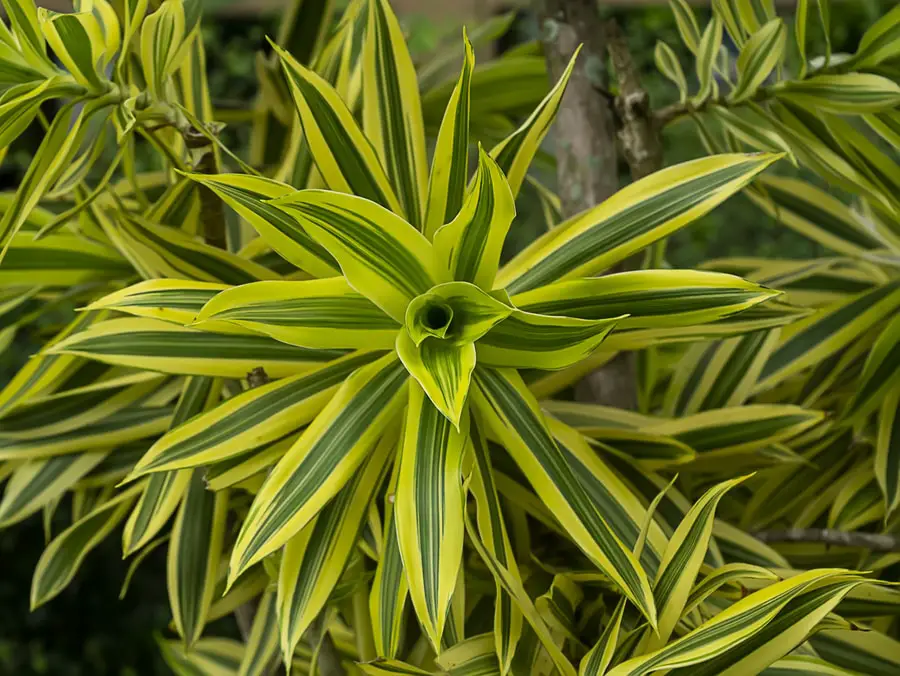
Dracaena is one of the most effective plants for removing allergens and gases that exacerbate allergies from indoor air. The NASA Clean Air Study confirmed Dracaena removes benzene, formaldehyde, and trichloroethylene, in addition to absorbing carbon monoxide. It’s also known for trapping allergens in its leaves.
Dracaena reflexa is one of the best variety for allergy sufferers due to it’s superior air cleaning ability. Several cultivars are available, including variegated types with lovely cream and yellow margins. Song of India (pictured above) makes a wonderful low maintenance houseplant.
| Light | Bright, filtered light without direct sun exposure. Can also thrive under artificial lights for 12 – 14 hours per day if an area of bright light isn’t available. Plant will become spindly without enough light. |
| Temperature | Maintain temperatures of 64 to 77 degrees F at all times. A tropical plant, Dracaena cannot tolerate very low or high temperatures. |
| Humidity | High Humidity. Place near a humidifier or on a humidity tray (a shallow tray filled with pebbles and water). Regular misting is recommended. |
| Water | A hardy houseplant, it tolerates infrequent watering. For the best results, water only when the top 50 percent of the soil becomes dry. |
| Fertilizer | Fertilize biweekly when the plant is actively growing using a basic houseplant fertilizer diluted to 1/4 the recommended strength. |
Areca Palm

According to the National Institute of Health’s 2011 study, Areca Palm is the number one best air purifying indoor plant. A natural humidifier, it improves allergy symptoms like nasal congestion and irritation by increasing the amount of water vapor in the air.
Areca Palm was also named in the NASA clean air study as one of the best purifiers for removing formaldehyde, carbon monoxide, xylene and toluene from the air. The large leaves are great for trapping allergens and filtering toxins from the environment.
| Light | Bright, indirect light. Place in a sunny east- or west-facing window or under artificial lights for 14 to 16 hours per day. Direct sunlight will burn the leaves. |
| Temperature | A constant temperature of 65 to 75 degrees F is best for Areca Palm. Keep away from cold windows, air conditioners, and heating/cooling vents. |
| Humidity | High Humidity. Place near a humidifier or on a humidity tray (a shallow tray filled with pebbles and water). Mist daily and keep away from heat sources, drafts, and vents. |
| Water | Moist, but never wet soil. Allow the top one inch of soil to dry between waterings. Make sure the soil drains well and the plant does not sit in water. |
| Fertilizer | Fertilize Areca Palm only once in Spring, Summer, and Fall with a time-released houseplant fertilizer. Spritz fronds with a micronutrient spray in Summer for the best results. |
English Ivy

English Ivy (Hedera helix) improves allergy symptoms by clearing the air of irritants and reducing airborne mold spores according to a recent study. This plant has worked wonders for us and I have several pots of English Ivy spread around our home.
Keep in mind that this plant is toxic to humans and animals, so keep it out of reach of children and pets. Place it on a high shelf and let it trail down for a lovely display, but trim it back before it gets long enough for your little ones to reach.
| Light | Bright, indirect light. Place in a sunny east- or west-facing window or under artificial lights for 14 to 16 hours per day. Will tolerate low to medium light, but may not grow as fast. |
| Temperature | Cool to moderate temperatures of 50 to 70 degrees F during the day are best, with nighttime temperatures of no more than 5 to 10 degrees cooler. |
| Humidity | Moderate humidity is best, although ivy will tolerate normal home levels. Good air circulation is necessary. Do not crowd. Place near a humidifier if possible. |
| Water | Allow the top 1/2 inch of soil to dry to the touch and then water thoroughly. Never allow Ivy to stand in water. |
| Fertilizer | Fertilize Ivy monthly with a foliage houseplant fertilizer during active growth. Do not feed when plants stop growing during the heat of summer or when temperatures are too cool. |
Spider Plant

A hardy houseplant that’s great for beginners, Spider Plant (Chlorophytum comosum) is almost impossible to kill. And best of all, it absorbs harmful molds and other allergens from the air. It’s an excellent choice for people with common dust allergies.
In addition, it removes toxins such as benzene, formaldehyde, carbon monoxide and xylene from the air. Xylene is a solvent used in the rubber, leather, and printing industries. An attractive plant that’s safe for kids and pets, allergy sufferers can’t go wrong with Spider Plant.
| Light | Bright, indirect light. Place in a sunny east- or west-facing window or under artificial lights for 14 to 16 hours per day. Exposure to direct sun will cause scorched leaves. Avoid west-facing windows, as the afternoon sun will be too strong. |
| Temperature | Moderate temperatures from 65 to 75 degrees F are best. Spider plants are sensitive to cold, so move them away from cold windows in the winter. |
| Humidity | High Humidity. Place near a humidifier and/or mist regularly. These plants thrive in bathrooms where humidity is high. |
| Water | Water only when the top 2 centimeters of soil are dry to the touch. Over watering is a big issue with these plants, so err on the side of caution. |
| Fertilizer | Fertilize three times a year at most with a water-soluble houseplant fertilizer at half strength. Make sure it’s free of fluoride and low in boron. |
Golden Pothos
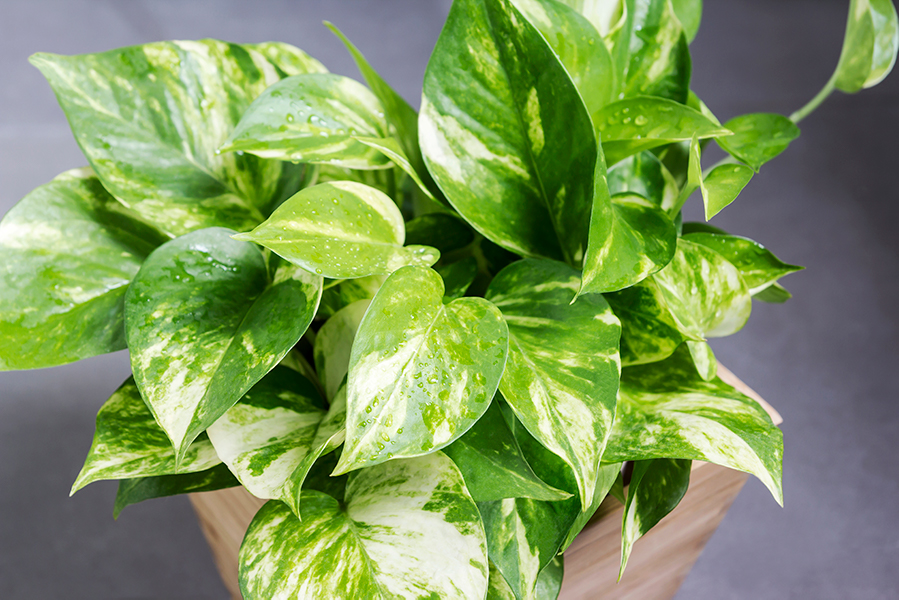
Also know as Devil’s Ivy, Golden Pothos (Epipremnum aureum) is an easy-care tropical houseplant known as one of the top houseplants for reducing formaldehyde indoors. In fact, it was in NASA’s top three – along with philodendron and spider plant. Formaldehyde increases irritation of the mouth, nose, and throat – which can make allergies even worse.
Golden pothos is my personal favorite houseplant. It was the first plant I ever grew successfully on my own, and I always have a few of them hanging around the house. Very easy to grow and with air purifying qualities, it makes a great addition to any room.
| Light | Bright, indirect light. Place in a sunny east- or west-facing window or under artificial lights for 14 to 16 hours per day. Low light conditions cause leaf variegation to fade, but it’s also important to avoid direct sun. |
| Temperature | Golden Pothos prefers warm temperatures of 70 to 80 degrees F during the day and 65 to 70 degrees F at night. They may suffer injury if temperatures drop below 50 degrees F. |
| Humidity | Medium Humidity. Keeping soil moist and misting regularly is usually enough. |
| Water | Water thoroughly when the top two inches of soil are dry to the touch. Do not allow Pothos to stand in water or it may develop root rot. |
| Fertilizer | During active growth, feed with a foliage houseplant fertilizer at half strength every six to eight weeks. Avoid feeding during the winter months when the plant is not growing. |
Heartleaf Philodendron
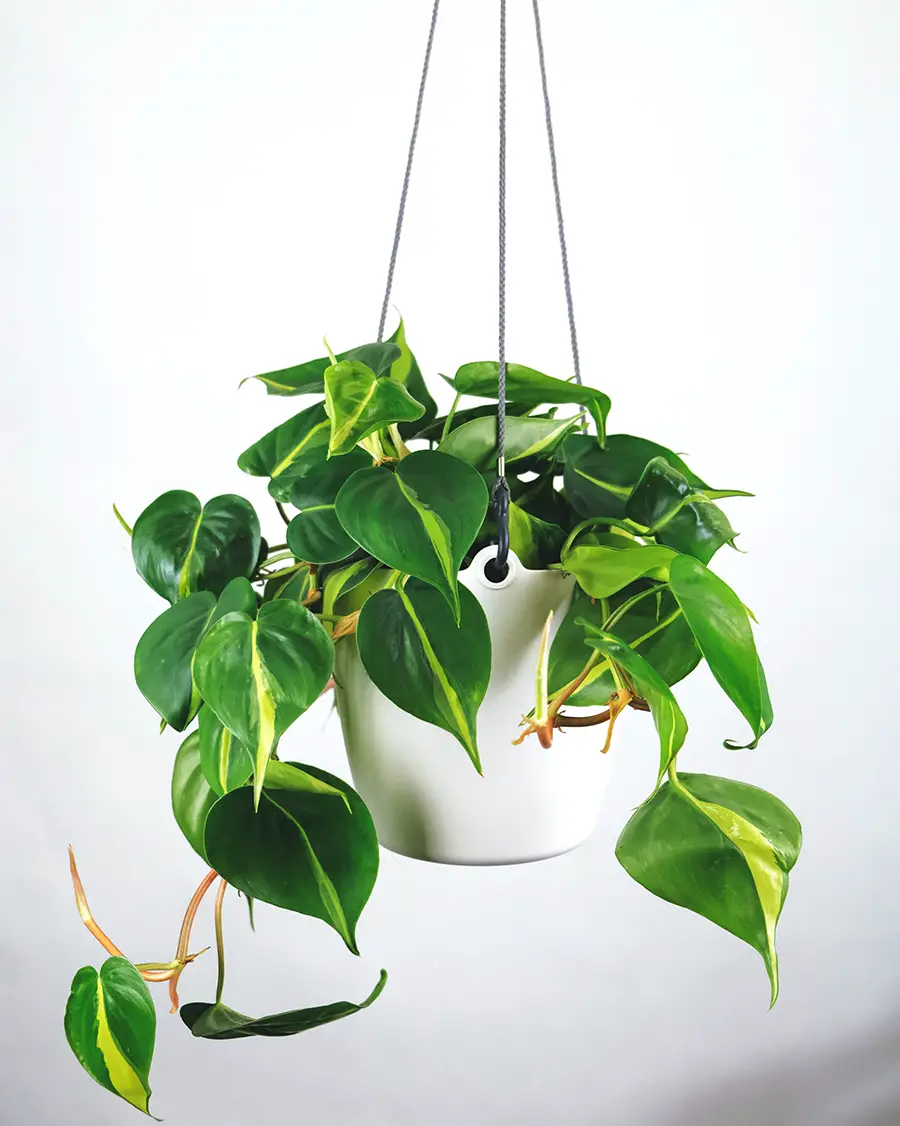
The heartleaf philodendron (Philodendron scandens) has been shown to improve indoor air quality, making it ideal for people who have allergies. This gorgeous foliage plant has the ability to scrub significant amounts of harmful gases out of the air during photosynthesis. And it doesn’t hurt that it’s super easy to grow!
It’s a good choice for placing around furniture that may be off-gassing irritating formaldehyde, since philodendron is especially good at fighting sources like particleboard.
| Light | Bright, diffuse light is best, although philodendron is tolerant of low light. Avoid direct sunlight as this can burn the leaves. Variegated types need more light. |
| Temperature | Average home temperatures are perfect for this houseplant, but temperatures below 50 degrees F are too low and can cause injury. |
| Humidity | High humidity is preferred, but these plants can tolerate low humidity levels found in most homes. For the best results, place near a humidifier or on a humidity tray (a shallow tray filled with pebbles and water). |
| Water | Water when the top inch of soil becomes dry to the touch. Avoid overwatering, which will cause yellowing of the leaves. |
| Fertilizer | Fertilize every 3 to 4 months using a houseplant fertilizer designed to promote foliage. |
Snake Plant

When making this list, I tried to choose the easiest to care for plants that have the biggest impact on allergies and air quality. Snake Plant (Sansevieria) is among the easiest of all plants to grow (and one of my favorite plants). You can neglect it for weeks, sometimes even months, and it still survives. This is a great choice for people who think they can’t grow anything.
In addition to it’s ease of care, Snake Plant (also known as Mother-in-Law’s Tongue) has been shown to reduce ozone concentrations in closed rooms. Because it converts carbon dioxide to oxygen at night, place Snake Plant in your bedroom for a better night’s sleep when your allergies are acting up.
| Light | Snake plant does well very bright light to low light. It may not grow much in very dim light, but it will survive just fine. Moderate light encourages more growth. |
| Temperature | Temperatures between 55 and 85 degrees F are best. Avoid prolonged temperatures below 50 degrees F to prevent injury. |
| Humidity | Low humidity. Unlike many other plants on this list, Snake Plant does not like high humidity. It will be fine in a typical home with no additional intervention. |
| Water | Overwatering is the enemy of Snake Plant. Water once every two to four weeks, only when the soil has dried out. In the winter, once a month watering is plenty. |
| Fertilizer | Fertilize with a mild cactus fertilizer once or twice during the active growing season (spring, summer). |
Rubber Tree
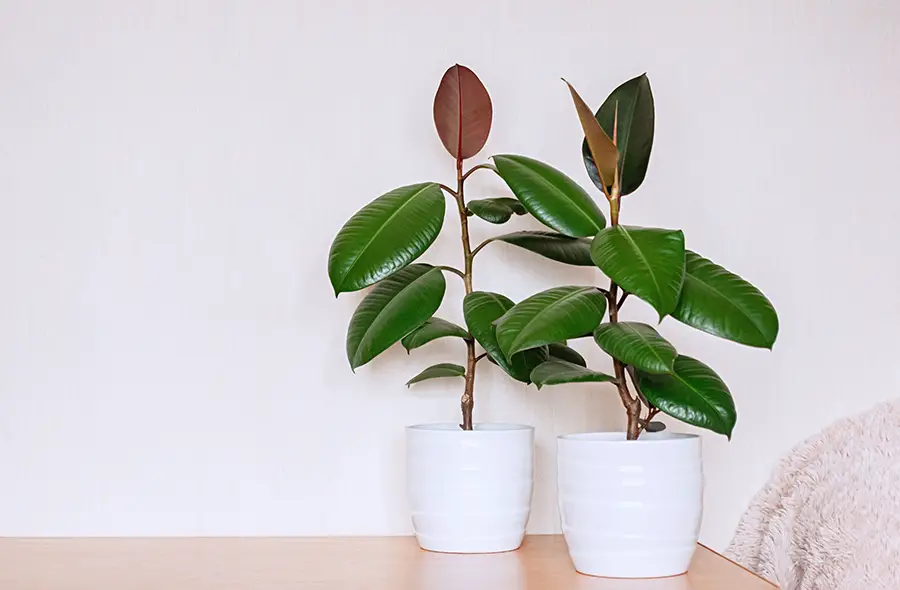
Another of the best houseplants for beginners and one of the top clean air plants, Rubber Tree (Ficus elastica) can help allergy sufferers by purifying the air of chemical toxins. The NASA studies recommend two rubber trees in 8- to 10-inch pots for every 100 square feet of space in your home.
Rubber tree is specially good at removing formaldehyde, which irritates the eye, nose, and throat when off-gassed by furniture, gas stoves, fireplaces, building materials, and more. It can even trigger asthma attacks if concentrations are high enough.
| Light | Bright, indirect light. Place in a sunny east- or west-facing window or under artificial lights for 14 to 16 hours per day. Will tolerate low light, but leaves may become inky. |
| Temperature | Warm temperature of between 75 and 80 degrees F during the day and 60 to 65 degrees F at night are best. Will still grow in any temperature above 55 degrees F. |
| Humidity | High Humidity. Place near a humidifier or on a humidity tray (a shallow tray filled with pebbles and water) if indoor humidity is very low. |
| Water | Water regularly during spring and summer while the plant is actively growing. Let soil dry to the touch between waterings. It’s always better to underwater than overwater. |
| Fertilizer | Feed every two weeks during spring and summer with a water-soluble houseplant fertilizer according to package directions. |
Dieffenbachia
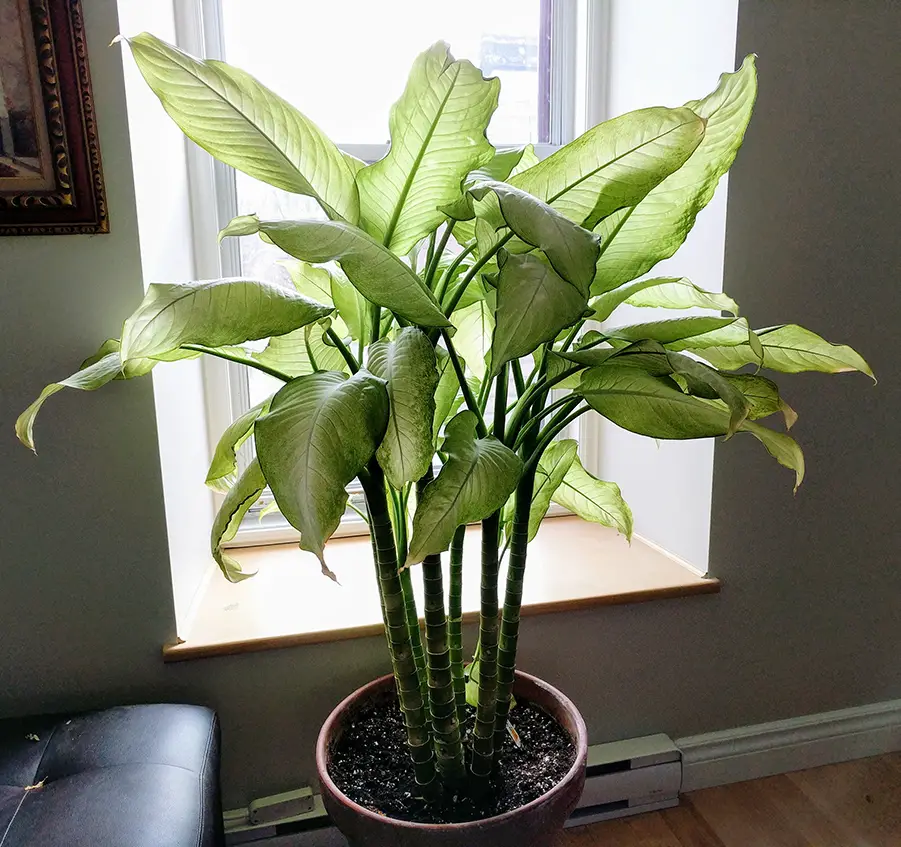
Dieffenbachia, also known as dumb cane, has been proven to remove the pollutants toluene and xylene from the air. These irritants aren’t good for allergies or respiratory health in general. Consider a variety with large leaves to filter out as much as possible.
Dumb cane gets it’s common name because it renders a person (or animal) “dumb” after consuming it. Ingestion causes stinging and burning in the mouth and throat, so keep this plant far away from pets and children. Easy to grow with beautiful foliage, it’s a nice addition to any room – even in low light.
| Light | Bright, indirect light is preferred, but will tolerate low light areas. Growth is slowed in low light, but the plant will survive just fine. |
| Temperature | The ideal temperature for dieffenbachia is 65 to 75 degrees F. Avoid temperatures below 50 degrees F to prevent injury. |
| Humidity | High humidity results in vigorous growth. Place near a humidifier or on a humidity tray (a shallow tray filled with pebbles and water). |
| Water | Maintain moist but not wet soil. Water thoroughly when the top of the potting soil is dry to the touch. Don’t allow the plant to become waterlogged. |
| Fertilizer | Dieffenbachia are heavy feeders. Use a balanced fertilizer such as 20-20-20 once every four to six weeks during active growth. |
How to Improve Allergies with Indoor Plants
According to the NASA clean air studies, 15 to 18 houseplants in 6- to 8-inch diameter containers will improve air quality in an 1800 square foot house. The more foliage the plants have, the more effective they are in purifying the air and improving allergy symptoms.
You don’t need 15 different plants, either. You can have three English ivy plants and five philodendrons, etc. If your budget is limited, try something like a spider plant. When it puts off pups, plant them in different containers and you’ll have multiple allergy fighting plants for the price of one.
Also, keep in mind that the healthier the plant is, the better it will improve air quality. Check out a good care guide for your plants to make sure they’re growing optimally and providing the most benefits.


